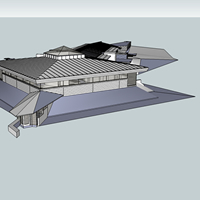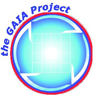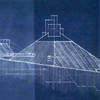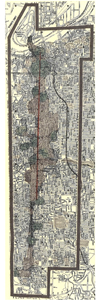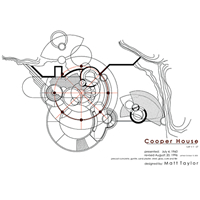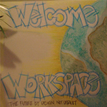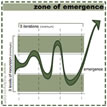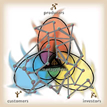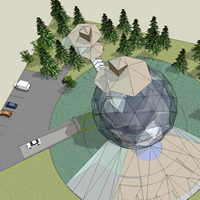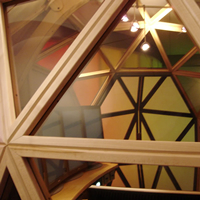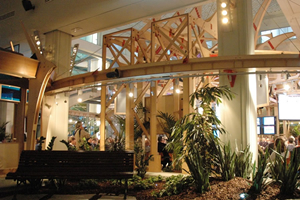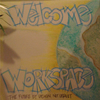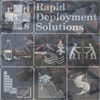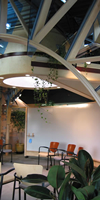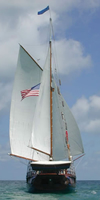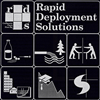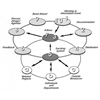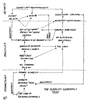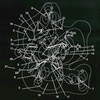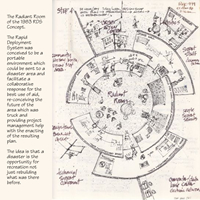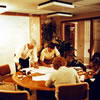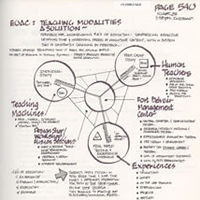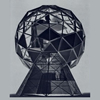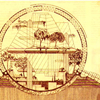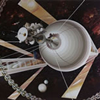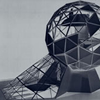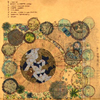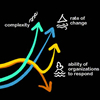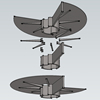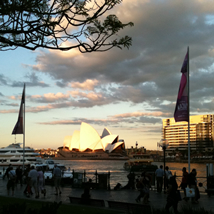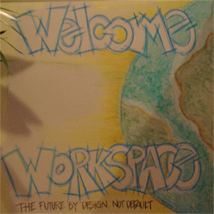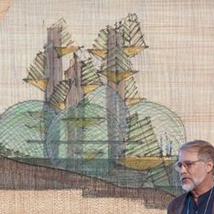note: this page is under construction |
A Future by Design by Employing GroupGenius Talk |
Outline Notes and links to Supplement the March 11, 2010 Presentation |
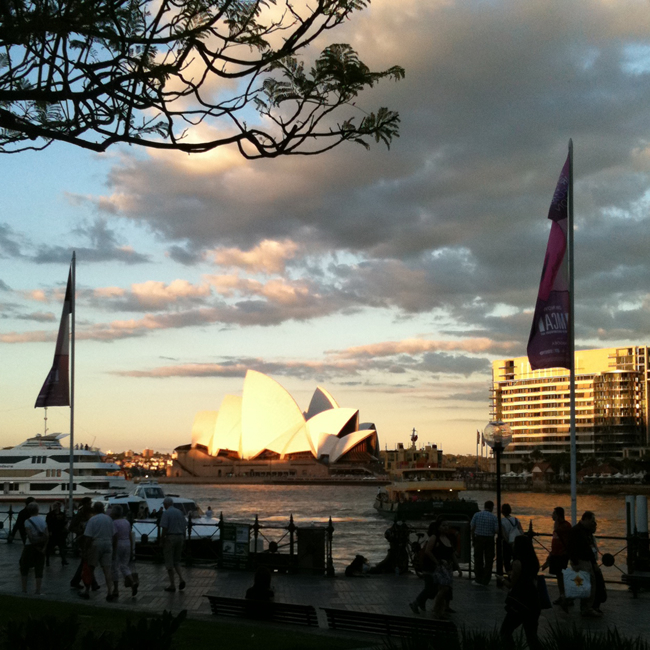 |
I choose this picture of the Sydney Opera House as the masthead for the documentations of my Talk and Workshop because of the iconic nature of the building and the struggles involved to bring it into being.
Even if we did not have to totally re conceive and recreate our entire global industrial civilization into a new kind of civilization which - and I believe we have to do precisely that - just the task of rebuilding our aging infrastructure alone constitutes a daunting challenge which - alone - is not near a sustainable solution. The scale and scope of the task ahead over the next generation is vast. If we do not accomplish it with grace, good engineering, humanity, a new economy-ecology paradigm and with art, millions maybe billions will die along with untold numbers of plants and animals and possibly Gaia herself.
|
Building a Masterpiece: The Sydney Opera House
click on icon to order book |
|
Take, as a bench mark, one of the greatest and innovative projects of the 20th Century, built in one of the most optimistic periods in history. it proved an almost impossible task and just now, 50 years later, is fully coming into being - are we more socially able today? |
|
| This is a question that everyone, I think, asks themselves at some point or another when they look, in any era, at the issues facing Humanity. I always wanted to be an architect and devoted 20 years to developing the skills necessary for the task only to discover that the world I wanted to build for was rapidly disappearing. This turned my life upside down and forced me to look at what was going on in the larger arena of life on this planet. |
| From my point of view, Humanity is not stewarding the Human Enterprise. We are “designing” our future by default. The task I gave myself was to apply design to the entire range of the human enterprise and to facilitate Transition Managers in their work of building a new future for all life on Earth - a future if it is be free and avoid a single point of failure strategy will include our journey into space. |
| This is not the work of a single person or a single lifetime. Gail became my partner and co-designer in this outrageous prospect and we created the model and means for a new way of working, a company to support the work and ultimately the ValueWeb of users which is now coming into being. We are ending one generation of work in what will be a two generation project just to turn the vector of humanity toward a creative, viable and life-sustain-able force. |
|
| Click on the lh icon to go to my 5 part paper, A Future By design - Not Default a subject which has occupied my attention - in thought and action - since 1974. |
|
|
| There are a set of issues which are systemic to human and planetary life in any era and most critical at a time of global transformation. These are conditions, not problems. Problems are created when The vision - the THERE - is significantly different from our present state - the HERE - and separated by a number of defined obstacles which can be dissolved by an executable design strategy. We call those problems which are critical and systemic yet solvable on both local and global levels Worthy Problems. |
Worthy Problems are not all that has to be done. Worthy Problems are those which have to be created and solved in order that the entire Human Enterprise can be viable and flourish in a sustainable way. Worthy Problems require the greatest level and skill of transition management. |
The issues underlying Worthy Problems have long been with us - they are as old as humanity. It has just been in the last few years that the focus of society is such that solvable problems are being created along with the means to systemically integrate them into a global agenda so that all of humanity can collaborate in the making of a new reality. In this coming reality, we cease being victims and become responsible designers of our own evolution and creative stewart of Earth with Gaia as an active partner. |
|
| Click on the lh icon for an outline of Worthy Problems, a focus of our work which emerged in the mid 80s after we achieved proof-of-concept with the Taylor Method. |
|
|
| A ValueWeb architecture is a necessary ingredient for any viable 21st Century organization. |
| In the past 70 years, the theories of Cybernetics, Systems and Networks have been enormously developed and demonstrated yet only fractionally applied to the design and practice of social systems: businesses, governments, non-profits and NGOs. As a consequence, human organizations lack the adaptability, flexibility and requisite variety necessary for proper functioning in the world which humanity is creating by the sum of trillions of actions taking place all over the Earth every day. This is a ubiquitous, systemic and technical problem. The ValueWeb organizational architecture is my design response to this condition. |
| Instead of vast global spanning corporations and governments, I expect to see the formation of millions of interlocking ValueWebs of different kinds functionally integrated on multiple levels of recursion from living communities, clusters of interest and expertise to economic/ecological bio regions. I think the time of the Nation State, no longer competent to govern - other than being a historical marker and a a social brand statement - is rapidly fading. |
|
| Click on the lh icon for a brief introduction of the ValueWeb concept. My research and design work with network organization structures goes back to the 60s. |
|
|
the present |
THERE |
soon to become the new HERE |
| The following MATRIX is made up of three event threads: historical moments which are part of my Strong Memory and make up aspects of who I am, ideas and projects which express my philosophy and design intent, and designs I have executed as I have sought to bring THERE - my vision - to HERE - the ever evolving present reality. |
| Click on the pictures and graphic to go to information of the subject in depth. Note also that there are interspersed sound clips from my Talk in Sydney on March 11th. |
| The period 1980 through 2012 is the first generation of a two generation project to facilitate a better transformational outcome for Humanity on Planet Earth. The period 1938 to 1980, is my 42 years of preparation to take on this task which includes 24 years of professional work in architecture, construction and futures research. |
|
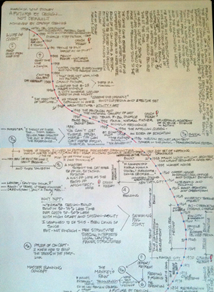 |
“Frank Lloyd Wright, in his Autobiography, wrote about the potential of a blank sheet of paper, a fist full of colored carefully sharpened pencils and the early morning hours uninterrupted by distractions. To him, such a moment was full of magic and opportunity - a world could spring forth from the white medium, the tools in his hand and the imagination latent in his mind.
“He wrote his autobiography in his late middle years of his career looking back to where he came form. Some 30 years of works were still before (him) yet few would believe this at the time.
“He never lost that sense of a limitless unfolding world to be made and remained young to the end.
“The game came before each of us and goes on long after yet it is different because we were here. Each of us can leave a better game to be played with delight by those youthful minds which follow.”
4:44 AM Sydney
March 9, 2010 |
|
| Page - of 2 pages - from my next Gen project Notebook outlining this Talk. My quote on the right is from this page |
|
|
“getting HERE from THERE” |
2012 |
|
|
|
|
|
|
|
|
|
2011 |
|
|
|
|
|
|
|
|
2010 |
|
|
|
|
|
| Domicile One Design Development - alternative to wage slavery |
|
2009 |
|
|
|
|
| Johnsonville Sausage navCenter in first purpose designed building |
|
|
|
2008 |
|
|
|
|
|
| The Media POD prototype installed at University of Virginia Medical Center is a tool for Remote Presence and Collaboration |
|
|
|
2007 |
| The Unicredit navCenter in Turin Italy was designed to facilitate the creation of a new Replacement Economy throughout the Northern region of Italy |
|
|
|
|
2006 |
| A Future by Design not Default the theme of the 06 Davos Workspace |
|
|
|
|
|
2005 |
|
| Katrina illustrated the extreme vulnerability of misplaced infrastructure |
|
|
|
|
|
|
|
|
2004 |
|
|
|
|
|
|
|
Masters Academy:
first navCenter in a school |
|
2003 |
|
|
|
|
|
|
|
|
|
2002 |
|
|
|
|
|
|
|
|
|
2001 |
|
|
|
|
|
|
|
|
|
2000 |
|
|
|
|
|
|
|
|
|
1999 |
|
|
|
|
|
|
|
|
|
1998 |
|
|
|
|
|
|
|
|
|
1997 |
|
|
|
|
|
|
|
|
|
1996 |
|
|
|
|
|
|
|
|
|
1995 |
|
|
|
|
|
|
|
|
|
1994 |
|
|
|
|
|
|
|
|
|
1993 |
|
|
|
|
|
|
|
|
|
1992 |
|
|
|
|
|
|
|
|
|
1991 |
|
|
|
|
|
|
|
|
|
1990 |
|
|
|
|
|
|
|
|
|
1989 |
|
|
|
|
|
|
|
|
|
1988 |
|
|
|
|
| RDS Proposal: scenario, use plan and cost model |
|
|
|
| CAMELOT came to us in 1988 to teach me about dynamic architecture |
|
1987 |
|
|
| Introduction of the 10 Step Process Model: Knowledge “Management” |
|
|
|
|
|
|
|
1986 |
|
|
|
|
|
|
|
| Gaia Projrct Concept: creating Speakers for Gaia |
|
|
1985 |
| UpSideDown Economics and the Scarsity Economics Trap |
|
|
| Business of Business Model developed for Acacia |
|
|
|
|
|
|
|
1984 |
|
|
|
|
|
|
|
|
|
1983 |
|
|
|
| RDS Concept to turn disaster not into recovery but into triumph |
|
|
|
|
|
1982 |
|
|
|
| Stories and description of the Boulder Anticipatory Management Center |
|
|
|
1981 |
|
|
|
|
|
| Education Model developed for the US Army |
|
|
1980 |
|
|
|
|
|
|
|
|
|
1979 |
|
|
|
|
|
|
| EcoSphere model developed at Renascence Project |
|
|
|
1978 |
|
|
|
|
|
|
|
|
|
1977 |
|
|
|
|
| DomicileOne for Kansas Citly Renascence Project |
|
|
|
|
|
1976 |
|
|
| Steinmeyer House - off the grid design for Kansas City |
|
|
|
| Interview with Nori Huddle, L5 society, architecture and Space Colonies |
|
|
|
|
1975 |
|
|
|
|
|
| Bootstrap into Space - a series of habitats doubling in size |
|
|
|
|
1974 |
|
|
|
|
|
|
|
|
|
1973 |
|
|
|
|
|
|
|
| Kansas City Master Plan - birth of the navCenter Concept |
|
|
1972 |
|
|
|
|
|
|
|
|
1971 |
|
|
|
|
|
|
|
|
1970 |
|
|
|
|
|
|
|
|
|
1969 |
|
|
|
|
|
|
|
|
|
1968 |
|
|
|
|
|
|
|
|
|
1967 |
|
|
|
|
|
|
| EcoSphere Concept: off the grid movable housing |
|
|
| Domicile Concept: affordable community urban living |
|
1966 |
|
|
|
|
|
|
|
|
|
1965 |
|
|
|
|
|
|
|
|
|
1964 |
|
|
|
|
|
|
|
|
|
1963 |
|
|
|
|
|
|
|
|
|
1962 |
|
|
|
|
|
|
|
|
|
1961 |
|
|
|
| NYC Build in one era - ROC in another: Rate of Change |
|
|
|
|
|
|
1960 |
|
|
|
| Cooper House pre cast concrete and gunite - open pavilion |
|
|
|
|
|
1959 |
|
|
|
|
|
|
|
1958 |
|
|
|
|
|
|
|
|
|
1957 |
|
|
|
|
|
|
|
|
|
1956 |
|
|
|
|
|
|
| Tower in a Park pre cast construction Housing for San Francisco |
|
|
|
1955 |
|
|
|
|
|
|
|
|
|
1954 |
|
|
|
|
|
|
|
|
|
1953 |
|
|
drawing
and link
coming
|
| Nichols Residence - my first client design - built without supervision |
|
|
|
|
|
|
1952 |
|
|
|
|
|
|
|
|
|
1951 |
|
|
|
|
|
|
|
|
|
1950 |
|
|
|
|
|
|
|
|
|
1949 |
|
|
|
|
|
|
|
|
|
1948 |
|
|
|
|
|
|
|
|
|
1947 |
|
|
|
|
|
|
|
|
|
1946 |
|
|
|
|
|
|
|
|
|
1945 |
|
|
|
|
|
|
|
|
|
1944 |
|
|
|
|
|
|
|
|
|
1943 |
|
|
|
|
|
|
|
|
|
1942 |
|
|
|
|
|
|
|
|
|
19411 |
|
|
|
|
|
|
|
|
|
1940 |
|
|
|
|
|
|
|
|
|
1939 |
|
|
|
|
|
|
|
|
|
1938 |
|
|
|
|
|
|
|
|
|
the 1980 |
HERE |
with 42 years of prior history |
| What I have Learned from this Journey: |
| The future is not predictable or controllable nor would we like it if it was. The future is complex and emergent and these are properties that our present society has neither the patience, tools or basic feel for. Thus, we keep trying to force our limited world views and “solutions” on each other while leaving the mess to the Planet to somehow clean up. It should be clear that we are in the last generation when this careless “design strategy” can be gotten away with. It is time to clean up the mess and have fun doing it. |
| Yet, “cleaning up the mess” understates it. We cannot clean it up and get a worthy result. We have to aim much higher. We have to build a new vision of Humanity and our fit with Planet Earth. One consequence of this - among many - will be the disappearing of a whole host of “problems” we are just now acknowledging exist and that we created as the unintended sum of our actions over hundreds of years. Mere improvement of the human condition will leave us way further behind by the time we are half way there to accomplishing it. This is the work of the “second generation.” Awareness is dawning and the tool kit is developed. Now, the fun begins. |
|
|
| The Work Ahead to Complete the 1st Generation of This Work: |
| After 54 years of professional work [this coming June, 2010] I have just arrived at “GO.” To me this means that we have created a system of work which has achieved proof-of-concept that it can deal with the issues of our time and produce better results, at less time and cost, while avoiding destructive unintended consequences. This means to me that I can now, with many members in the ValueWeb, get to work as a designer “rebuilding Earth as a work of art” for equal use by “all life forms.” |
| The immediate work ahead is to get the global network of navCenters in place, along with a properly scaled ValueWeb of KnowledgeWorkers, so that a capacity exists in time to address the systemic issues which are now beginning to be daily front page news. This is not a simple task as it means the existing market for the work has to support building a much larger system in anticipation of the greater complexities to come. Most people assume they are all ready dealing with significant complexity with their present ventures and enterprises. My response to this is “you ain’t seen nothing yet.” Not by orders of magnitude. |
|
|
posted:
March 14, 2010 • updated: April 14, 2010 @ 11:33 AM Elsewhere |
|
|
|
GoTo:
DesignShop Method
|
GoTo:
Taliesin Return
|
|
|
GoTo:
A Furture by Design Paper |
GoTo:
A Testament |
|
|
